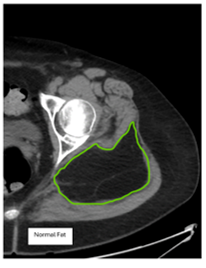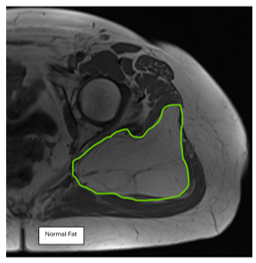Author: Kyle Sweeney, MD, FAAOS, FAOA
Description
An Atypical Lipomatous Tumor (ALT) is a type of soft tissue tumor made up of fat cells that look a little different from normal fat. These tumors can grow anywhere in the body but are most commonly found deep in the buttock, thigh, or shoulder area.
There has been some confusion over how these tumors are named. You may also hear them called: Well-differentiated liposarcoma, Lipoma-like liposarcoma or Atypical lipoma. These names have changed over time as doctors have learned more about the behavior of these tumors.
ALTs in the extremities (the focus of this article) are not known to metastasize (spread to other sites in the body) and have very low rates of changing into a malignant tumor (dedifferentiated liposarcoma). However, when similar tumors are found deep in the belly (called the retroperitoneum), they can behave more aggressively and carry a higher risk.
Symptoms
The most common symptom in patients with an ALT of a limb is a painless, slow growing lump. These tumors are typically soft, though they may feel firmer if they get very large. ALTs usually don’t cause pain or other problems unless they grow big enough to press on nearby nerves or limit movement.
Examination
In most cases there is a slowly enlarging, painless, mobile lump in the deep tissues of the thigh, buttock or shoulder. However, ALTs can be present almost anywhere in the body. They typically do not hurt when touched. The growth rate is variable, but they can grow slowly over months or even years before being noticed.
Tests
X-Rays may show a soft tissue mass, but they usually don’t give enough detail. CT scans can show a fatty tumor and how much blood flow it has, especially when contrast dye is used (Figure 1). The ideal exam is an MRI with and without IV contrast (Figure 2). The tumor often looks like normal fat but may have thin bands or spots inside them that are not seen in regular lipomas (fatty tumors). Some of these spots, if enhancing with contrast, can raise concern for a more serious type of tumor (dedifferentiated liposarcoma). To be sure of the diagnosis, doctors often test the tumor for a gene change called MDM2. This change is not found in regular lipomas, so it helps confirm whether the tumor is an ALT.
Images
Figure 1: CT scan showing an ALT (in green) in the left buttock. Note the similar density to normal surrounding healthy fat. A thickened striation is also noted running through the posterior third of the mass.

Figure 2: MRI of an ALT (in green) of the left buttock from the same patient as Figure 1. Note the similar appearance with normal fat as well as the internal striations and lobulation of the tumor. There are no areas of nodularity concerning for dedifferentiated liposarcoma.

Prognosis
ALT tumors in the arms and legs do not spread to other parts of the body. Because of this, doctors now avoid calling them “well-differentiated liposarcomas” when they are in areas where surgery can fully remove them.
The chance that an ALT in the arms or legs will turn into a more serious cancer (called dedifferentiated liposarcoma) is very low—less than 1–2%. In fact, the long-term survival rate is excellent, even at 10 or even 20 years for people with ALTs in these areas. However, when the tumor is located deep in the belly (called the retroperitoneum), the risk is much higher. In those cases, over 20% may become cancer, and more than 80% of patients may not survive 20 years, according to some studies.
This is a rare tumor in the general population. Due to its rarity, it is highly recommended that patients are treated by an orthopaedic oncologist who has experience treating these tumors. When occurring in the extremities, this tumor is not classified as malignant. However, it will continue to grow over time if left untreated.
The most common treatment is surgery to remove the entire tumor. Ideally, the tumor should be removed in one piece to lower the risk of it coming back. If the tumor is broken up during removal, there’s a higher chance it will grow back in the same area.
Many factors such as the location of the tumor, risks of surgery, age, and overall health of the patient should go into consideration for surgical decisions. Because ALT rarely turns into cancer in the arms or legs, some patients may choose to simply watch the tumor over time, especially if it’s not causing problems. This option should be discussed with your specialist.
More Information
Lipoma and Atypical Lipomatous Tumors - OrthoInfo - AAOS
This is not intended as a substitute for professional medical advice and does not provide advice on treatments or conditions for individual patients. All health and treatment decisions must be made in consultation with your physician(s), utilizing your specific medical information. Inclusion in this is not a recommendation of any product, treatment, physician or hospital.


